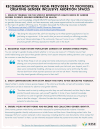Opportunities for improving abortion care: a key stakeholder analysis of best practices for addressing the needs of transgender, nonbinary, and gender expansive people seeking abortions
- PMID: 39334401
- PMCID: PMC11437809
- DOI: 10.1186/s12978-024-01863-5
Opportunities for improving abortion care: a key stakeholder analysis of best practices for addressing the needs of transgender, nonbinary, and gender expansive people seeking abortions
Erratum in
-
Correction: Opportunities for improving abortion care: a key stakeholder analysis of best practices for addressing the needs of transgender, nonbinary, and gender expansive people seeking abortions.Reprod Health. 2024 Oct 16;21(1):145. doi: 10.1186/s12978-024-01886-y. Reprod Health. 2024. PMID: 39415249 Free PMC article. No abstract available.
Abstract
Objectives: Transgender, nonbinary, and gender expansive (TGE) persons experience pregnancies and have abortions, yet abortion care remains rooted in a gender binary, often centering the needs, experiences, and challenges of cisgender women. Despite guidance supporting gender-affirming sexual and reproductive healthcare (SRH), barriers for TGE people seeking abortions persist. We conducted an exploratory case study with key informants to understand their perception of TGE abortion seekers' needs with specific considerations for those in restrictive abortion settings.
Methods: Qualitative interviews focused on gender-affirming care and abortion provision were conducted with U.S.-based key informant clinicians (n = 4) who could provide powerful insights into gaps and experiences faced by TGE individuals. Participants were eligible if they currently or previously provided abortions and had experience practicing gender-affirming care. Interviews focused on informants' perceptions of TGE patients' needs when seeking abortions.
Results: Findings highlight the unique barriers TGE patients face when seeking abortions, including lack of provider knowledge, in-clinic stigmatization, and gender marginalization. It is notable that key informants who practiced in abortion-protective political environments have greater access to resources to implement gender-affirming care than those in restrictive contexts. Results are summarized in a clinical recommendations document which provides an accessible starting point for clinicians to begin building gender-inclusive abortion spaces.
Conclusions: It is necessary to further understand barriers facing TGE abortion seekers and integrate recommendations and emerging evidence into abortion practice. This study contributes to a growing knowledge base which emphasizes the need for inclusive abortion spaces and highlights key considerations for improving access and quality for TGE abortions seekers.
Keywords: Abortion care; Case study; Gender-affirming care; Health care delivery; Sexual and reproductive health; Transgender, nonbinary, and gender expansive health.
© 2024. The Author(s).
Conflict of interest statement
The authors declare no competing interests.
Figures
Similar articles
-
Stakeholder Perceptions and Experiences Regarding Access to Contraception and Abortion for Transgender, Non-Binary, and Gender-Expansive Individuals Assigned Female at Birth in the U.S.Arch Sex Behav. 2020 Oct;49(7):2683-2702. doi: 10.1007/s10508-020-01707-w. Epub 2020 May 8. Arch Sex Behav. 2020. PMID: 32385584
-
Abortion experiences and preferences of transgender, nonbinary, and gender-expansive people in the United States.Am J Obstet Gynecol. 2021 Apr;224(4):376.e1-376.e11. doi: 10.1016/j.ajog.2020.09.035. Epub 2020 Sep 25. Am J Obstet Gynecol. 2021. PMID: 32986990 Free PMC article.
-
Pregnancy intentions and outcomes among transgender, nonbinary, and gender-expansive people assigned female or intersex at birth in the United States: Results from a national, quantitative survey.Int J Transgend Health. 2021 Nov 17;22(1-2):30-41. doi: 10.1080/26895269.2020.1841058. eCollection 2021. Int J Transgend Health. 2021. PMID: 34796363 Free PMC article.
-
Beyond the Binary: Sexual and Reproductive Health Considerations for Transgender and Gender Expansive Adolescents.Front Reprod Health. 2021 Oct 6;3:670919. doi: 10.3389/frph.2021.670919. eCollection 2021. Front Reprod Health. 2021. PMID: 36304055 Free PMC article. Review.
-
Reproductive health risks and clinician practices with gender diverse adolescents and young adults.Andrology. 2021 Nov;9(6):1689-1697. doi: 10.1111/andr.13026. Epub 2021 May 24. Andrology. 2021. PMID: 33942552 Free PMC article. Review.
Cited by
-
Correction: Opportunities for improving abortion care: a key stakeholder analysis of best practices for addressing the needs of transgender, nonbinary, and gender expansive people seeking abortions.Reprod Health. 2024 Oct 16;21(1):145. doi: 10.1186/s12978-024-01886-y. Reprod Health. 2024. PMID: 39415249 Free PMC article. No abstract available.
References
-
- Moseson H, Zazanis N, Goldberg E, Fix L, Durden M, Stoeffler A, Hastings J, Cudlitz L, Lesser-Lee B, Letcher L, Reyes A, Obedin-Maliver J. The imperative for transgender and gender nonbinary inclusion: beyond women’s health. Obstet Gynecol. 2020;135(5):1059–68. 10.1097/AOG.0000000000003816. - PMC - PubMed
-
- Moseson H, Fix L, Ragosta S, Forsberg H, Hastings J, Stoeffler A, Lunn MR, Flentje A, Capriotti MR, Lubensky ME, Obedin-Maliver J. Abortion experiences and preferences of transgender, nonbinary, and gender-expansive people in the United States. Am J Obstet Gynecol. 2021;224(4):376.e1-376.e11. 10.1016/j.ajog.2020.09.035. - PMC - PubMed
-
- Fix L, Durden M, Obedin-Maliver J, Moseson H, Hastings J, Stoeffler A, Baum SE. Stakeholder perceptions and experiences regarding access to contraception and abortion for transgender, non-binary, and gender-expansive individuals assigned female at birth in the U.S. Arch Sex Behav. 2020;49(7):2683–702. 10.1007/s10508-020-01707-w. - PubMed
-
- Hastings J, Geilhufe B, Jaffe JM, Rapues J, St. Amand C. Creating inclusive, gender affirming clinical environments. In: Moravek MB, de Haan G, editors. Reproduction in transgender and nonbinary individuals: a clinical guide. Springer International Publishing; 2023. pp. 177–207.
Publication types
MeSH terms
Grants and funding
- K12 HD085850/HD/NICHD NIH HHS/United States
- KL2 TR002381/TR/NCATS NIH HHS/United States
- U1TR002378/National Center for Advancing Translational Sciences of the National Institutes of Health
- KL2TR002381/Georgia Clinical and Translational Science Alliance (GCTSA)
- K 12: GM000680/GM/NIGMS/NIH HHS/United States
LinkOut - more resources
Full Text Sources
Medical


